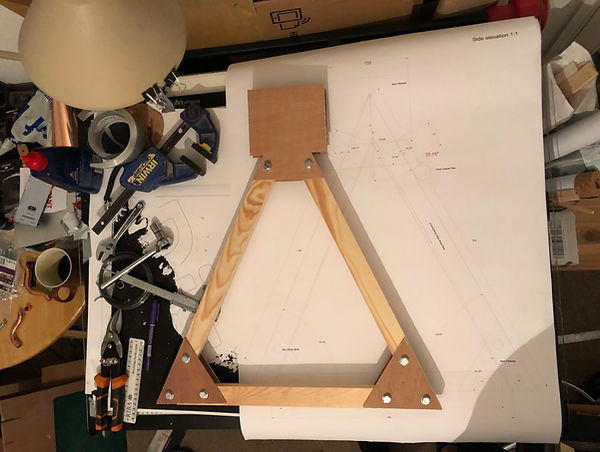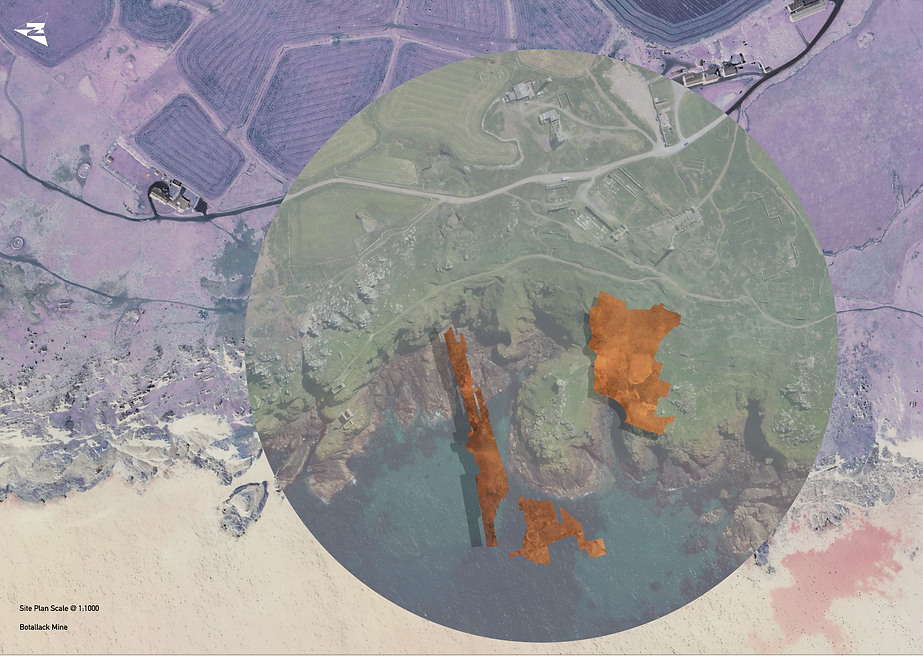Arc 310 Blog
Exploratory project, exploring different and avenues of investigation using a device to heighten one of the five senses, exploring alternative technologies, presentation and setting our own briefs for an inhabited structure on the tin coast from Cape Cornwall to Pendeen lighthouse.

Botallack mine ruins sunset
Exploring the scarred landscape of the tin coast, by mountain bike as a tool speeding up the visual exploration of the area and getting to experience the topography by working to get to the peaks and speeding down to the troughs.

10/09/19 Staying to the dying light reveals the beauty of the sunset and layering of clouds, accentuates the colours (near Levant).

week 1
First site visit walking the coast starting from Cape Cornwall and making it to Botallack that day I captured the sites through sketching and photography.
Walking the coast line for the first time rather than riding allowed me to experience, understand and gain new respect for the landscape.

Kedinjack Valley Sketches


West Wheal Owles Sunset and Sketches.
The characteristics and architectural features of the engine house and the apertures from within the structure drew my attention to the picturesque view of the coastline, not the original purpose of a working building housing an engine for the tin mining industry.

Path journey through the coast
Week 2
Selecting a site for implementing a exploratory device.
Botallack was my choice for the site, it spoke to me because of the rich history and the amount of
remaining buildings from the many periods of tin mining industry in Cornwall, from the 19th century arsenic labyrinth, to the 21st century steel structure.
The mine has one of the larges diagonal shafts in Europe that reached 2.5km under the sea bed.

Chimney for arsenic flue and Calciner


Analysis of the weather conditions of the site predominant wind direction is SW & the sun path is East to West.


Exploring the site it became apparent that there is a clear layering of time periods and technology, with the 1980s addition of the head frame on the Allen shaft at Botallack.
The arsenic labyrinth at Botallack is a very interesting and intriguing structure that has a curious and enjoyable experience as its very special to walk around the structure but the purpose of it was a poison and a by product of the mining industry.

Visiting the archives at Kresken Kernow

Exploring the archives uncovered a mass of interesting historical data & maps, sections & plans of the whole coastline.
Focussing on Botallack Mine gave me a much clearer understanding of the scale of the processes and structures that have been created on the site.

Unrolling the scrolls of historical maps that are kept in the archives was a long process and sometimes required two pairs of hands to handle these relics of the mining industry.
It also required a step ladder and taking numerous photos to piece together one roll.

Plan of botallack 1800s
Geevoor Tin mine site visit

While visiting Geevor tin mine towards the exit, stumbling upon the bone yard where there was a mass of fading manufacturing history that was very intriguing to walk around and wonder what it was used for?
The weird and wonderful machinery that was lying unused for nearly 30 years drew in the ideas of this very loud clattering of machinery and red being crushed, staked and processed to extract the precious minerals.


Visiting the drill workshop and seeing the scale of the drill 4ft tall and drill bits 6ft or 8ft, made me think of the lugging this kit all the way down in the mine and bringing it back up at the end of the day must of been a physical job within its self without drilling all day.
Going into the mine was a very interesting experience of being underneath the ground is a slightly worrying felling of impending doom and collapse from above, but as the bedrock is granite there is little chance of it happening.
Interestingly its a quite warm and damp with the occasional drip of water on your person, the cramped bent over posture that was required to progress through as a 6ft man was slightly painful as it was a hand carved shaft there was one what needed to be taken away by smaller boys.

week 3
Designing & Making exploratory device.

After visiting Geevor and reviewing the images this top of a head frame used as a gateway inspired the structure of my device as I wanted to use the site to inform me about it.

Setting out template that was print a 1:1
Steel wire was bent to the shape of the coastline to also use the site to inform.


Constructing the frame out of 4mm plywood and pine using the 1:1 template
Mid construction one side done one to go


Completed device with alternate length copper pipe pendulums with different scribes and different shaped tin cans to catch the wind and power the drawing machine.
Deploying exploratory device.







The results from the device didn't really inform me of anything that was gripping to follow an area of investigation.
but the sound of tapping of the copper pipe stuck me of the sound of tapping within the mines which led me to investigate sound qualities
week 4
development of new device

After the tapping sound and reviewing the archive files of the mines at botallack I wanted to investigate the volumes and voids that are underneath the ground

So I investigated the total volumes of extracted minerals away from the site and there was:
- 20,000 tonnes of Copper
- 14,500 tonnes of Tin
- 1,500 tonnes of Arsenic


In comparison to the scale of the coastline compared to the scaled up volumes of the tonnes of materials is colossal.


After plotting the positions of the device deployment and thinking of the lodes.
Concept idea:
-
series of interlocking experience pods
-
different sound qualities in each
-
tunnels/shafts connecting pods


This concept didn't have much legitimacy with placing metals that were extracted from the site and replacing them around the buildings that still exist seemed a bit obvious and clichè
week 5
interim Review

Interim Review
during the review there were a number of consecutive comments and suggestions:
-
exploring the sound qualities further
-
not choosing copper tin as a material just because its what came from the site
-
exploring the sound qualities from within the voids
week 6
Further exploration of sound

I went to the sire on two different days:
-
on a very windy day with 20mph winds and 38mph gusts, misty and raining
-
extreme weather visceral experience
-
a very sunny day 5mph wind and 15mph gusts
-
tranquil place
-
pleasant hearing the birds chirping
This discovery of the two very different days two days apart made me thing of using the extreme weather of making it more of a spectacle.

-
I decided to explore the sound qualities of the lodes by laser cutting the shapes and creating a void and paper mâché on the sides with copper tape.
-
the results were as expected as it was a wooden box effectively
-
the faces of the box were flat as opposed to the reality of the textured fractured rock
-
reduced the effectiveness
Week 7

3D mine shaft model supplied by abandonedminemodels.com
mapping of lodes and other information by myself.

The development of the concept and brief was to:
Concept
- Replacing lodes/ void from under the sea to the land
- Rebirth of the voids
Brief
1 Lode
- Visitor Centre
- Experience of the mine recreation of the sound qualities
- Framing views
- Sound qualities of the site
Lode 2
- Theatre space placed on the cliff
Lode 3
- Submersed experience of the mines due to the flooding.


Week 8
2nd review
Comments from second review:
-
stick with one lode 3 isn't needed
-
does it need to be represented at 1:1
-
more texture detail on the lodes as the surface wouldn't be a flat geometry.
-
3d scan a stone/ piece of granite to gain the texture.
-
the large lode sticking out of the cliff face "beautifully bonkers".
-
Which made me want to pursue the 1:1 recreation of the lode and placing an this large intervention in the continuously interrupted landscape.
Retreat from project

retreating from the project for sanity and being with nature, but never away from architecture whether man made or using nature to make architecture.


Week 9
Form and texture exploration

Understanding the geometry of stone and the texture of rock I tried to make a maquette out of clay to get a better understanding but it didn't work as well Id like.

so I tried carving a piece of stone to get the desired effect, carving a 1:500 lode out of alabaster.
it was a satisfying experience smashing up a piece of stone to create a shape.
I used this stone carving to 3d scan to produce a shell.


dividing up the geometry caused a few issues when I came to producing a structure.
Form and texture development

following the 3d geometry i wanted to implement this into the form or structure some how by creating a shell.
Finding work and play balance

finding a balance between work and play I went to Dartmoor hiking 7miles each day and staying over night and exploring Devons mining history.
quarry in dartmoor

Week 11
Form and texture exploration

following the the decision to move on from the shell form and structure simplifying the design and extracting the form 8ft by 8ft same as the mining process.



Week 12
Form and texture exploration

trying to get Vectorworks to function when producing a very complex colossal scaffolding does this to you laptop and high stress levels.
Final review

following the review suggestions to what supports the scaffolding was an issue which led to using oil rigs and offshore wind turbine foundations as a precedent.


Work after final review







The project was a challenging one for me personally as it pushed me outside my comfort zone when I came to producing my own brief and coming up with a very conceptual idea.
In reflection I would like to develop the design further as the scale of the building got a bit too much to handle in the end within the timescale provided.
